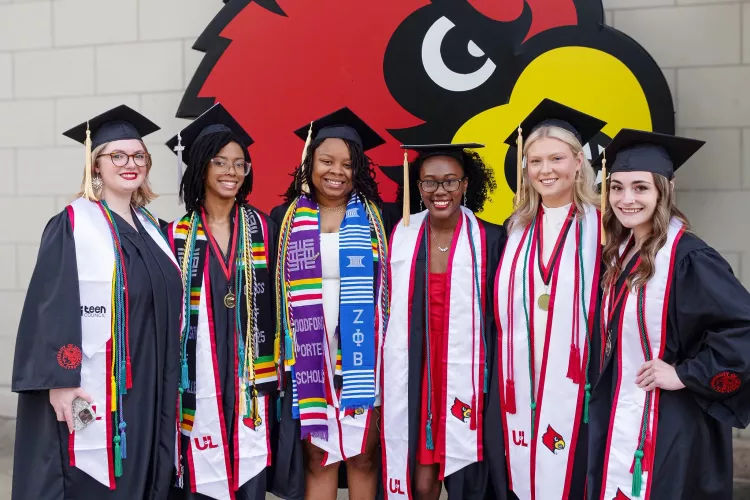UofL's campus has been disrupted before. COVID-19 is different
October 2, 2024There are a few times in the University of Louisville’s history when business as usual was disrupted a bit. In 1917, more than half of our Arts & Sciences upperclassmen had volunteered for, or had been drafted, into the U.S. armed forces to fight World War I, for example.
During World War II, the university was part of the V-12 program, which not only infused UofL with students, but also enabled the university to build its first dorms to accommodate them.
A fire destroyed a student cafeteria in 1951, shifting a centralized socializing spot to a former Navy V-12 mess hall, where it stayed until 1959.
The floods of 1937 and 2009 affected a majority of the Louisville community, including UofL’s campuses. In 2009, UofL closed many of Belknap buildings for repair and moved employees into alternative locations, like trailers, to work.
Nothing, however, comes close to the disruption caused by the COVID-19 pandemic. In mid-March, much of the university – from classes to business operations and everything in between – shifted entirely online as part of a statewide stay-at-home mandate.
Not only were operations upended, so too were basic milestones. The Class of 2020 never got to walk across the stage at the Yum! Center. Internships abruptly ended. UofL Basketball never experienced the madness of March.
And so forth.
How do you possibly explain this unprecedented experience for posterity? UofL’s Archives and Special Collections and the Kornhauser Library on the HSC campus are trying to do just that with their requests for the UofL community’s experiences and reflections of life during the pandemic.
Archives and Special Collections started its call to action in late March and continues to seek submissions. According to Carrie Daniels, university archivist and director, the idea behind launching this collection was built on experience from past disruptions (namely, the floods of 1937 and 2009), and by benchmarking other universities, like UNC Charlotte and Harvard, doing similar projects.
“We knew that in the future, community members and historians in general would want to know about people’s experiences at this time. Collections like this also serve as a centerpiece for remembering,” she said. “The materials can provide a sort of touchstone for people to remember and process their own stories, or to recount and make sense of family stories that have come down from previous generations.”
These types of hand-me-down recounts have happened frequently with the flood of 1937, in particular, she said. By the time of the 2009 flood, many materials moved to a digital format, which creates a different experience for posterity. This disparity informed Archives and Special Collections on how to approach its COVID-19 collection.
“For the flood of 1937, we are still getting donations of photographs taken, diaries kept and newspapers clipped. Digital files are not as hardy,” Daniels said. “Photographs and video taken with cell phones, blog posts and the like can be very ephemeral. We have all had the experience of corrupted digital files we can’t open, or photos that don’t get transferred onto a new device. So we really wanted to be proactive, asking people to donate materials while events were still unfolding, or to consciously preserve and hold on to them to donate later.”
Still, the department is collecting any format – photos, videos, textual documents like diaries, audio files, art, name it.
“People document and process experiences in a variety of ways, and we didn’t want to place restrictions on what we would accept,” Daniels said.
So far, the themes that have emerged from submissions have largely resonated with what “our own” feelings have been through this moment, she said. The department has received images of empty grocery store shelves and an empty campus, for example.
The project is ongoing, since events are still unfolding. Right now, the plan is to collect and preserve the material, then open it up to the public based on permissions from donors.
Simultaneously, UofL is also serving as a preservation and access partner for the Frazier Museum for a similar project. The museum began reaching out to the community around the same time the university launched its call to action. UofL is providing digital preservation expertise and access to digital and analog content for the long term. Daniels said there is a plan to partner on an exhibit eventually, but adds any such event “will have to wait until the community is healed enough, when there is enough distance that we can reflect, and not resurface trauma.”
From her unique perspective, Daniels said this experience feels more like the terrorist attacks of Sept. 11, 2001, than it does, for example, the floods of 1937 or 2009.
“With the floods, the waters soon receded and we got on with the very positive task of rebuilding,” she said. “The period of time where people’s lives were threatened was, in relation to the current pandemic, rather brief.”
Conversely, like Sept. 11, the pandemic has changed the way we interact with each other and the world.
“We are part of the world and are not immune – literally – to the things that plague the rest of the world,” she said. “A sense of safety has been lost, maybe irretrievably.”



